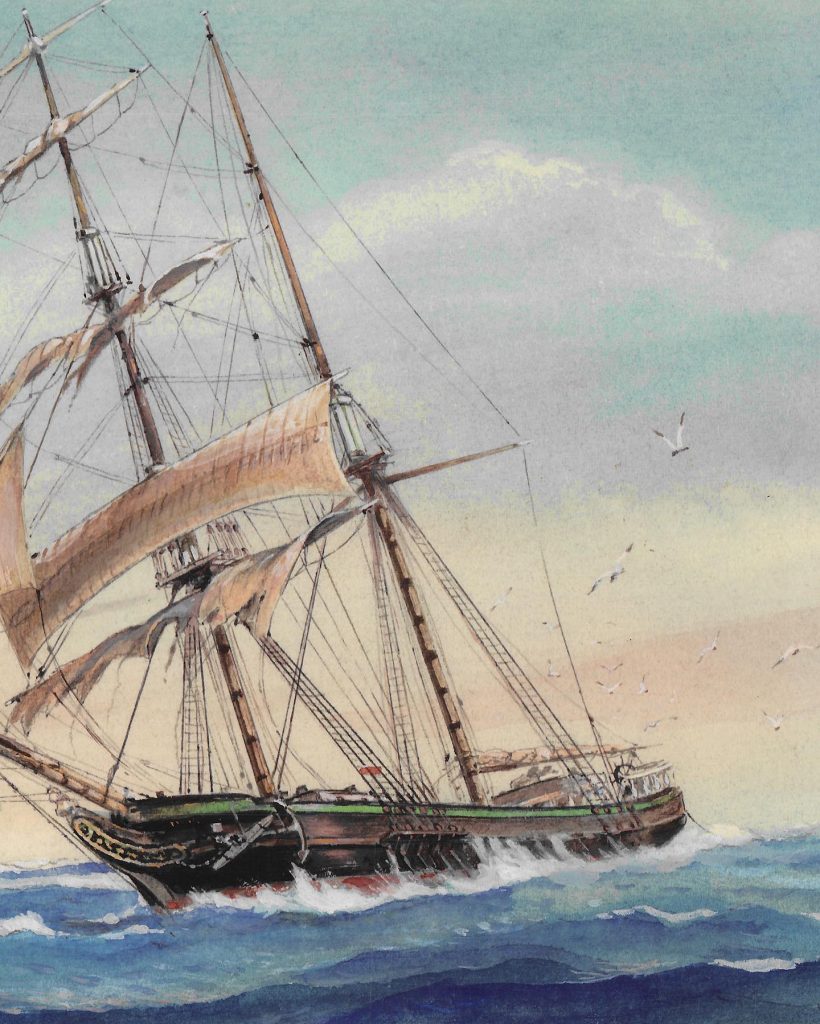
Merchant brigantine Mary Celeste. At first sight, this illustration by E. W. Wojschwillo does not seem specially creepy. It nevertheless shows a scene of one of the greatest mysteries in maritime history: the fate of the Crew of the Mary Celeste.
At first sight, this illustration by E. W. Wojschwillo does not seem specially creepy. It nevertheless shows a scene of our of the greatest mysteries in maritime history: the fate of the Crew of the Mary Celeste.
On December the 4th 1872, the brigantine Mary Celeste was sighted 590 nautical miles from Gibraltar by the American brigantine Dei Gratia. Captain Morehouse of the Dei Gratia saw that the Mary Celeste was drifting on the water with sails hanging down slackly. He knew her captain Benjamin Spooner Briggs to be a good seaman and was worried. As he approached, there was no one on deck, no one at the helm. Morehouse worryingly gave the order to launch a boat and board the Mary Celeste. The search the ship only brought up more questions: there was no trace of the crew, the captain or his family, that was known to be aboard. The ship was in good condition, with some minor damage, just like after a storm. There was water in the hold, but not to a dangerous amount. Two hatches were open as to ventilate the fumes produced by the cargo of denaturalized alcohol the ship was taking to Genoa. Personal belongings of those aboard had been left behind, tobacco pouches and pipes lay on the forecastle, sufficient provisions for six months were on board, and there was also enough drinking water. The ship’s rudder was still functional. Only the lifeboat, the chronometer and sextant were missing. The open log book was found on the captain’s table. The last entry was dated 24 November, eight o’clock. The ship’s location had been about a hundred miles south-west of the Azores. Captain Morehouse had the water drained from the hold, took the Mary Celeste in tow and brought her to Gibraltar. There she was immediately impounded and thoroughly examined. But there were no indications as to what could have caused the entire crew to disappear. They were never heard of again and all the investigations could bring up was a long list theories. Her fate as ghost ship brought up many supernatural theories as well.
Despite open questions, there sure was a natural explanation for the mystery of the Mary Celeste. But coastal residents and sailors had their own opinions. For many of them, the ship built in Nova Scotia in 1861 had been an unlucky vessel from the start. Shortly after the christening, then named Amazon, the ship’s first captain died of a strange illness. On its maiden voyage, the ship ran aground and was badly damaged. In 1862, it collided with a brig in the Straits of Dover and again suffered heavy damage. In 1867, it ran aground on Cape Breton Island and the hull had such severe damage that experts did not initially believe it could be repaired. But the merchant Alexander Mac Bean took the risk, bought the wreck and had it repaired. With the new name „Mary Celeste“ he hoped to avert further misfortune. The ship set sail from New York on 7 November 1872 on its mysterious voyage. Despite its bad reputation, it changed hands several times thereafter, but remained dogged by misfortune. In 1884 it ended up on a reef in the West Indies, the last owner unable to free himself from suspicion of insurance fraud until his death.
